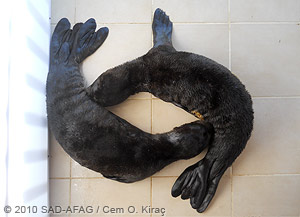Letters to the Editor
The last issue of TMG included a “photo quiz” promoted by the Italian Monk Seal Group – Gruppo Foca Monaca: the photo was one out of 41 shots taken by a tourist from a low cliff near the tower of Campese, on the north-western part of Giglio, and the marine mammal was at about 20 meters distance from the coast. The sighting lasted for more than half an hour, and other people were present. TMG staff comment was very clear: “As far as TMG is concerned… we think we see two seals (to judge from the stretched appearance and the subtle foreground shape…)”.
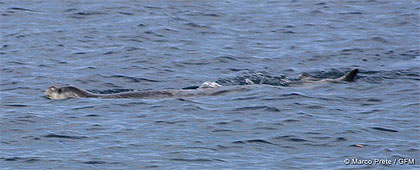

I would like here to give my personal evaluations to the event. As GFM, we made an accurate evaluation of the photo (including all the others), and we reached the same conclusion: the presence, at the same moment and in the same place, of two animals, something that was not at all noticed by the photographer.
One of the two seals was sighted many times (approx. 10), from 11:58 up to 12:35. The photos were taken in this lapse of time with a professional Canon, using a 200 mm zoom, and with 3 shots/second setting.
The animal looked very disturbed, raising the head out of the water, a behaviour clearly visible in the photo no. 1, the first of seven shots, where the sixth (photo no. 2) shows how the seal was looking towards “something” just behind, and not towards the observers that were standing up on the cliff.
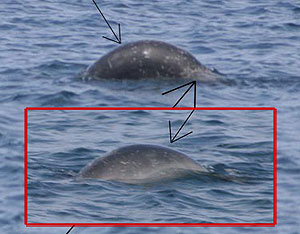
A second sequence of three shots (11:59) shows the second seal diving (photo no.3): it is possible to notice the difference from the first seal looking at the skin colour, much darker (typical of adult males). Have a look at the insets included in the same picture: the colour is much lighter.
Several shots, including the one featured in the “photo quiz”, show the lighter seal together with a part view of hind flippers, placed in a position impossible to be its own: the most likely explanation is that the other seal was just underneath, trying to catch her: a behaviour suggestive of courtship.
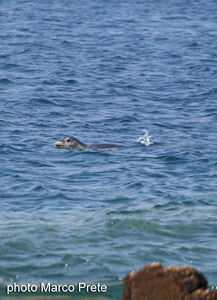
Finally, within the lapse of time between the first and the last picture, the lighter seal did not move away from the cliff, but – as it is shown in the last photo (photo no. 4) – she came closer, further confirming that she did not care very much about the people watching her from the rocks.
If I can add some further considerations to the description of the behaviour of such a still rather unknown species, (I guess somebody could define it as enriched by personal “insights”), I must admit that I was a bit frustrated by the fact that there were no other notes or comments to the “photo quiz”, apart from the one of TMG. This aspect can be assumed as a clear symbol of the lack of ideas or information exchange among the community dealing with monk seal study and conservation. I am personally convinced that monk seals can be saved only through a sincere and clear exchange of ideas and information among all those involved in their conservation. I unfortunately learned, on several occasions, that this does not happen at all, and this “behaviour” often involves those that work “professionally” on the issue. The reasons for such “scientific discretion” can vary and are sometimes understandable, but we should not forget that the monk seal is one of the rarest species on earth, and any information, even partial, is extremely important for the conservation community, to improve the protection.
— Emanuele Coppola – Gruppo Foca Monaca Italia
Photo gallery containing all the photos from Giglio: http://www.naturaindiretta.com/gfm/giglio/index.htm
TMG replies: After making comparisons with other photographs of adult female Mediterranean monk seals TMG had to reverse its opinion that “we think we see two seals” in the picture of the “photo quiz”. Comparing pictures, we thought it much more likely that it shows just one animal. Also now, after finally seeing all the pictures in the gallery, we see no convincing evidence to the contrary. — Matthias Schnellmann

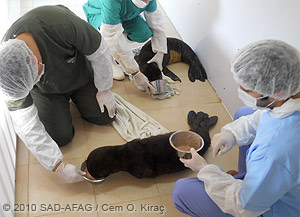 This is certainly preferable to tube-feeding – if the pups will take sufficient food this way. However, better still would be to enable the pups to suck by bottle-feeding. Have you attempted this? There is a baby’s soft silicone nursing bottle available (Tommee Tippee Nuby natural touch soft flex silicone nurser). This enables you to squeeze the bottle gently with the teat in the pup’s mouth and give the pup the idea of sucking from the bottle. It might be worth a try.
This is certainly preferable to tube-feeding – if the pups will take sufficient food this way. However, better still would be to enable the pups to suck by bottle-feeding. Have you attempted this? There is a baby’s soft silicone nursing bottle available (Tommee Tippee Nuby natural touch soft flex silicone nurser). This enables you to squeeze the bottle gently with the teat in the pup’s mouth and give the pup the idea of sucking from the bottle. It might be worth a try.